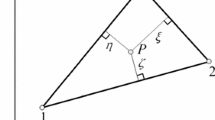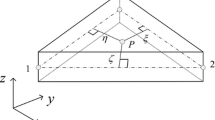Abstract
This paper investigates two new types of planar finite elements containing three and four nodes. These elements are the reduced forms of the spatial plate elements employing the absolute nodal coordinate approach. Elements of the first type use translations of nodes and global slopes as nodal coordinates and have 18 and 24 degrees of freedom. The slopes facilitate the prevention of the shear locking effect in bending problems. Furthermore, the slopes accurately describe the deformed shape of the elements. Triangular and quadrilateral elements of the second type use translational degrees of freedom only and, therefore, can be utilized successfully in problems without bending. These simple elements with 6 and 8 degrees of freedom are identical to the elements used in conventional formulation of the finite element method from the kinematical point of view. Similarly to the famous problem called “flying spaghetti” which is used often as a benchmark for beam elements, a kind of “flying lasagna” is simulated for the planar elements. Numerical results of simulations are presented.









Similar content being viewed by others
References
Song, J.O., Haug, E.J.: Dynamic analysis of planar flexible mechanisms. Comput. Methods Appl. Mech. Eng. 24, 359–381 (1980)
Shabana, A.A., Wehage, R.A.: Coordinate reduction technique for transient analysis of special substructures with large angular rotations. J. Struct. Mech. 11(3), 401–431 (1983)
Belytschko, T., Hsieh, B.J.: Nonlinear transient finite element analysis with convected coordinates. Int. J. Numer. Methods Eng. 7, 255–271 (1973)
Rankin, C.C., Brogan, F.A.: An element independent corotational procedure for the treatment of large rotations. J. Press. Vessel Technol. 108, 165–174 (1986)
Simo, J.C.: A finite strain beam formulation. The three-dimensional dynamic problem, Part I. Comput. Methods Appl. Mech. Eng. 49, 55–70 (1985)
Simo, J.C., Vu-Quoc, L.: A three-dimensional finite strain rod model, Part II: Computational aspects. Comput. Methods Appl. Mech. Eng. 58, 79–116 (1986)
Shabana, A.A.: Flexible multibody dynamics: review of past and recent developments. Multibody Syst. Dyn. 1, 189–222 (1997)
Shabana, A.A.: Definition of the slopes and the finite element absolute nodal coordinate formulation. Multibody Syst. Dyn. 1(3), 339–348 (1997)
Hughes, T.J.R.: The Finite Element Method. Prentice-Hall, Englewood Cliffs (1987)
Shabana, A.A., Yakoub, R.Y.: Three dimensional absolute nodal coordinate formulation for beam elements: theory. J. Mech. Des. 123(4), 606–613 (2001)
Gerstmayr, J., Shabana, A.A.: Analysis of thin beams and cables using the absolute nodal co-ordinate formulation. Nonlinear Dyn. 45(1–2), 109–130 (2006)
Von Dombrowski, S.: Analysis of large flexible body deformation in multibody systems using absolute coordinates. Multibody Syst. Dyn. 8(4), 409–432 (2002)
Gerstmayr, J., Matikainen, M.K., Mikkola, A.M.: A geometrically exact beam element based on the absolute nodal coordinate formulation. J. Multibody Syst. Dyn. 20, 359–384 (2008)
Schwab, A.L., Meijaard, J.P.: Comparison of three-dimensional flexible beam elements for dynamic analysis: classical finite element formulation and absolute nodal coordinate formulation. J. Comput. Nonlinear Dyn. 5(1), 011010 (2010) (10 pages)
Nachbagauer, K., Gruber, P.G., Vetyukov, Yu., Gerstmayr, J.: A spatial thin beam finite element based on the absolute nodal coordinate formulation without singularities. In: Proc. of the ASME 2011 Int. Design Eng. Techn. Conf. & Computers and Information in Eng. Conf. IDETC/CIE 201. Washington, DC, USA, August, pp. 28–31 (2011)
Mikkola, A.M., Shabana, A.A.: A non-incremental finite element procedure for the analysis of large deformation of plates and shells in mechanical system applications. Multibody Syst. Dyn. 9(3), 283–309 (2003)
Dmitrochenko, O.N., Pogorelov, D.Yu.: Generalization of plate finite elements for absolute nodal coordinate formulation. Multibody Syst. Dyn. 10, 17–43 (2003)
Omar, M.A., Shabana, A.A.: A two-dimensional shear deformable beam for large rotation and deformation problems. J. Sound Vib. 243(3), 565–576 (2001)
Sopanen, J.T., Mikkola, A.M.: Description of elastic forces in absolute nodal coordinate formulation. Nonlinear Dyn. 34(1), 53–74 (2003)
Garcia-Vallejo, D., Mikkola, A.M., Escalona, J.L.: A new locking-free shear deformable finite element based on absolute nodal coordinates. Nonlinear Dyn. 50(1–2), 249–264 (2007)
Nachbagauer, K., Pechstein, A., Irschik, H., Gerstmayr, J.: New locking-free formulation for planar, shear deformable, linear and quadratic beam finite elements based on the absolute nodal coordinate formulation. J. Multibody Syst. Dyn. 26(3), 245–263 (2011)
Kubler, L., Eberhard, P., Geisler, J.: Flexible multibody systems with large deformations and nonlinear structural damping using absolute nodal coordinates. Nonlinear Dyn. 34(1–2), 31–52 (2003)
Gerstmayr, J., Schoberl, J.: A 3D finite element method for flexible multibody systems. Multibody Syst. Dyn. 15(4), 309–324 (2006)
Olshevskiy, A., Dmitrochenko, O.: Three-dimensional solid elements employing slopes in the absolute nodal coordinate formulation. In: Proc. of the 24th Nordic Seminar on Computational Mechanics, Helsinki, 2011.11.3–4, pp. 162–165 (2011)
Dmitrochenko, O., Mikkola, A.: A formal procedure and invariants of a transition from conventional finite elements to the absolute nodal coordinate formulation. Multibody Syst. Dyn. 22(4), 323–339 (2009)
Dufva, K., et al.: Nonlinear dynamics of three-dimensional belt drives using the finite-element method. Nonlinear Dyn. 48(4), 449–466 (2007)
Weed, D., Maqueda, L., Brown, M., Hussein, B., Shabana, A.: A new nonlinear multibody/finite element formulation for knee joint ligaments. Nonlinear Dyn. 60(4), 357–367 (2010)
Gantoi, F., Brown, M., Shabana, A.: ANCF finite element/multibody system formulation of the ligament/bone insertion site constraints. J. Comput. Nonlinear Dyn. 5(3), (2010), 9 pages
Abdullah, M.A., Michitsuji, Y., Nagai, M., Miyajima, N.: Analysis of contact force variation between contact wire and pantograph based on multibody dynamics. J. Mech. Syst. Transp. Logist. 3(3), 552–567 (2010)
Wan, H., Dong, H., Ren, Y.: Study of strain energy in deformed insect wings dynamic. In: Behavior of Materials. Conference Proceedings of the Society for Experimental Mechanics Series, vol. 1, pp. 323–328. Springer, New York (2011)
Hrennikoff, A.: Solution of problems of elasticity by the frame-work method. ASME J. Appl. Mech. 8, A619–A715 (1941)
Melosh, R.J.: Structural analysis of solids. ASCE Struct. J. 4, 205–223 (1963)
Dmitrochenko, O., Mikkola, A.: Digital nomenclature code (dnc) of finite element kinematics and its modification (dncm) for absolute nodal coordinates. In: Proc. of 1st Int. Joint Conf. for Multibody System Dynamics (IMSD-2010), Lappeenranta, 25–27.05.2010 (2010)
Dufva, K., Shabana, A.: Analysis of thin plate structures using the absolute nodal coordinate formulation. J. Multibody Dyn. 219, 345–355 (2005). Proceedings of the Institution of Mechanical Engineers, Part K
Specht, B.: Modified shape functions for the three node plate bending element passing the patch test. Int. J. Numer. Methods Eng. 26, 705–715 (1988)
Zienkiewicz, O.C., Taylor, R.L.: The Finite Element Method. Solid Mechanics, vol. 2. Butterworth, London (2000)
Gere, J.M., Timoshenko, S.P.: Mechanics of Materials, 4th edn. PWS, Boston (1997), 912 pages
Simo, J.C., Vu-Quoc, L.: On the dynamics of flexible beams under large overall motions—the plane case: Parts I and II. J. Appl. Mech. 53, 849–863 (1986)
Pogorelov, D.: Some developments in computational techniques in modeling advanced mechanical systems. In: van Campen, D.H. (ed.) Proc. of IUTAM Symp. on Interaction between Dynamics and Control in Advanced Mech. Systems, pp. 313–320. Kluwer Academic, Dordrecht (1997)
Acknowledgements
This paper was supported by Konkuk University in 2012.
Author information
Authors and Affiliations
Corresponding author
Rights and permissions
About this article
Cite this article
Olshevskiy, A., Dmitrochenko, O. & Kim, C. Three- and four-noded planar elements using absolute nodal coordinate formulation. Multibody Syst Dyn 29, 255–269 (2013). https://doi.org/10.1007/s11044-012-9314-y
Received:
Accepted:
Published:
Issue Date:
DOI: https://doi.org/10.1007/s11044-012-9314-y




